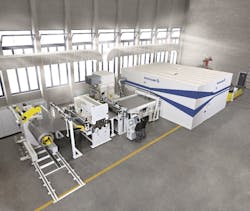Decomecc adds laser blanking line
Decoiling and metal cutting company Decomecc (Genk, Belgium) relies on a Schuler laser blanking line for cutting customized blanks flexibly from aluminum coils. They have been producing shaped blanks on this line since the beginning of 2019.
As a service center, Decomecc says flexibility of the line plays a major role. New blank shapes can be programmed and integrated for production within one day and product changes can be done without time-consuming changing of heavy dies. Material savings are achieved by an optimal nesting of the blanks, resulting in significantly more parts being produced per aluminum coil.
Blanking without dies is particularly useful for Decomecc because the number of variants, and thus the number of orders, does not depend on the available storage capacities for the dies. Also, the laser blanking line does not require any extraordinary building infrastructure for the handling of the dies or special foundations for a press, which significantly reduces investment costs and facilitates installations in existing buildings. The continuous flow of the strip while cutting makes a loop pit superfluous.
Laser blanking lines cannot cover the full capability of a conventional blanking line with a blanking press, but in some cases they can reach 60-70% of the output, depending on the contour. In addition, they have an Overall Equipment Effectiveness (OEE) of approximately 80%: In many cases, new laser blanking lines offer a higher net output rate than existing conventional equipment.
The laser cell incorporates two laser portals in which the three lasers move independently of each other. The continuous strip material is transported on conveyor belts through the cell. Directly beneath the 4 kW IPG Photonics fiber laser cutting heads, a mobile gap in the conveyor system allows the cutting slag to be discharged into the underlying separation system.
With just a few clicks, the blanking program can be readjusted with the results immediately examined and the blanks stacked accurately at the end of the system. The simple adjustment of the laser parameters offline or directly online enables a good and fast process optimization. Combined with the simple implementation of new laser programs, laser blanking is clearly recommended by Decomecc for companies that produce a large variety of small batch sizes and need to change frequently.
For more information, please visit decomecc.be and schulergroup.com.
